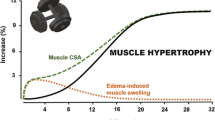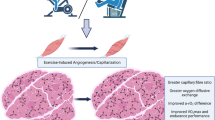Abstract
Cardiac hypertrophy is a response to long-term pathologic (eg, hypertension) or physiologic (eg, exercise) hemodynamic overload accompanied by changes in energy substrate utilization. The pattern of substrate utilization (or metabolic phenotype) differs dramatically between pathologic and physiologic cardiac hypertrophy with directionally opposite changes in oxidation of fatty acids and glucose and glycolysis. These findings indicate that the metabolic response to long-term alterations in hemodynamic workload is not stereotypical, but is influenced by the nature of the stimulus leading to cardiac hypertrophy. Although the changes in substrate utilization are adaptive, in the case of pathologic stimuli, the changes in metabolism interfere with functional resiliency of the heart to metabolic stress, as occurs during ischemia-reperfusion. The distinct metabolic phenotypes of hearts hypertrophied in response to pathologic or physiologic stimuli are due not only to alteration in expression of metabolic enzymes and proteins, but also to post-translational modulation of metabolic enzymes and proteins.
Similar content being viewed by others
References and Recommended Reading
Swyngedhauw B: Molecular mechanisms of myocardial remodeling. Physiol Rev 1999, 79:215–262.
Frolich ED, Apstein CS, Chobanian AV, et al.: The heart in hypertension. N Engl J Med 1992, 327:998–1008.
Moore RL, Korzick DH: Cellular adaptations of the myocardium to chronic exercise. Prog Cardiovasc Dis 1995, 37:371–396.
Grossman W, Jones D, McLaurin LP: Wall stress and patterns of hypertrophy in the human left ventricle. J Clin Invest 1975, 56:56–64.
Taegtmeyer H: Genetics of energetics: transcriptional responses in cardiac metabolism. Ann Biomed Eng 2000, 28:871–876. This article provides a good overview of the possible relationship among gene transcription, energy substrate metabolism, and contractile function in hearts adapting to altered hemodynamic workloads.
Young ME, Laws FA, Goodwin GA et al.: Reactivation of peroxisome proliferators-activated receptor alpha is associated with contractile dysfunction in hypertrophied rat heart. J Biol Chem 2001, 276:44390–44395.
Frey N, Olson EN: Cardiac hypertrophy: the good, the bad, and the ugly. Annu Rev Physiol 2003, 65:45–79.
Richey PA: Pathological versus physiological left ventricular hypertrophy: a review. J Sports Sci 1998, 16:129–141.
Gaasch WH, Zile MR, Hoshino PK, et al.: Tolerance of the hypertrophic heart to ischemia. Studies in compensated and failing dog hearts with pressure overload hypertrophy. Circulation 1990, 81:1644–1653.
Anderson PG, Allard MF, Thomas GD, et al.: Increased ischemic injury but decreased hypoxic injury in hypertrophied rat hearts. Circ Res 1990, 67:948–959.
Wambolt RB, Lopaschuk GD, Brownsey RW, et al.: Dichloroacetate improves post-ischemic function of hypertrophied rat hearts. J Am Coll Cardiol 2000, 36:1378–1385.
Kannel WB: Vital epidemiological clues in heart failure. J Clin Epidemiol 2000, 53:229–235.
Moore RL, Palmer BM: Exercise training and cellular adaptations of normal and diseased hearts. Exerc Sport Sci Rev 1999, 27:285–315.
Burelle Y, Wambolt RB, Grist M, et al.: Regular exercise is associated with a protective metabolic phenotype in the rat heart. Am J Physiol 2004, 287:41055–41063.
Bowles DK, Farrar RP, Starnes JW: Exercise training improves cardiac function after ischemia in isolated working rat heart. Am J Physiol 1992, 263:H804-H809.
El Alaoui-Talibi Z, Guendouz A, Moravec M, et al.: Control of oxidative metabolism in volume-overloaded rat hearts: effect of propionyl-L-carnitine. Am J Physiol 1997, 272:H1615-H1624.
Vincent G, Khairallah M, Bouchard B, et al.: Metabolic phenotyping of the diseased rat heart using 13C-substrates and ex vivo perfusion in the working mode. Mol Cell Biochem 2003, 242:89–99.
Allard MF, Schonekess BO, Henning SL, et al.: Contribution of oxidative metabolism and glycolysis to ATP production in hypertrophied hearts. Am J Physiol 1994, 267:H742-H750.
Lehman JJ, Kelly DP: Gene regulatory mechanisms governing energy metabolism during cardiac hypertrophic growth. Heart Fail Rev 2002, 7:175–185. This review summarizes molecular studies aimed at delineating the gene regulatory events that facilitate energy substrate switches, especially that of fatty acid oxidation, during hypertrophic growth of the heart.
Stanley WC, Chandler MP: Energy metabolism in the normal and failing heart: potential for therapeutic interventions. Heart Fail Rev 2002, 7:115–130.
Neely JR, Morgan HE: Relationship between carbohydrate and lipid metabolism and the energy balance of heart muscle. Annu Rev Physiol 1974, 36:413–457.
Saddik M, Lopaschuk GD: Myocardial triglyceride turnover and contribution to energy substrate utilization in isolated working rat hearts. J Biol Chem 1991, 266:8162–8170.
Henning SL, Wambolt RB, Schonekess BO, et al.: Contribution of glycogen turnover to aerobic myocardial glucose utilization. Circulation 1996, 93:1549–1555.
Van der Vusse GJ, van Bilsen M, Glatz JF: Cardiac fatty acid uptake and transport in health and disease. Cardiovasc Res 2000, 45:279–293.
Lopaschuk GD, Belke DD, Gamble J, et al.: Regulation of fatty acid oxidation in the mammalian heart in health and disease. Biochim Biophys Acta 1994, 1213:263–276.
Depre C, Rider MH, Hue L: Mechanisms of control of heart glycolysis. Eur J Biochem 1998 258:277–290.
Stanely WC, Lopaschuk GD, Hall JL, et al.: Regulation of myocardial carbohydrate metabolism under normal and ischemic conditions: potential for pharmacological interventions. Cardiovasc Res 1997, 33:243–257.
Brownsey RW, Boone AN, Allard MF: Actions of insulin on the mammalian heart: metabolism, pathology and biochemical mechanisms. Cardiovasc Res 1997, 34:3–24.
Sambandam N, Brownsey RW, Allard MF: Energy metabolism of the hypertrophied heart. Heart Fail Rev 2002, 7:161–173. A review that provides a comprehensive overview of energy substrate metabolism in pathologic cardiac hypertrophy.
El Alaoui-Talibi Z, Landormy S, Loireau A, et al.: Fatty acid oxidation and mechanical performance of volume-overloaded rat hearts. Am J Physiol 1992, 262:H1068-H1074.
Allard MF, Wambolt RB, Henning SL, et al.: Hypertrophied rat hearts are less responsive to the metabolic and functional effects of insulin. Am J Physiol 2000, 279:E487-E493.
Tian R, Musi N, D’Agostino J, et al.: Increased adenosine monophosphate-activated protein kinase activity in rat hearts with pressure-overload hypertrophy. Circulation 2001, 104:1664–1669.
Lopaschuk GD, Spafford MA, Marsh DR: Glycolysis is the predominant source of ATP production immediately after birth. Am J Physiol 1991, 261:H1698-H1705.
Tian R: Transcriptional regulation of energy substrate utilization in normal and hypertrophied heart. Curr Hypertens Rep 2003, 5:454–458. This paper provides a concise overview of transcriptional changes that may be responsible for the energy substrate switch, involving glucose and fatty acids, in cardiac hypertrophy.
Taegtmeyer H: Metabolism: the lost child of cardiology. J Am Coll Cardiol 2000, 36:1386–1388.
Lopaschuk GD, Reybeka IM, Allard MF: Metabolic modulation: a means to mend a broken heart. Circulation 2002, 105:140–142.
Lopaschuk GD, Wambolt RB, Barr RL: Imbalance between glycolysis and glucose oxidation is a possible explanation for the detrimental effects of high levels of fatty acids during aerobic reperfusion of ischemic hearts. J Pharmacol Exp Ther 1993, 264:135–145.
Liu B, Clanachan AS, Schulz R, et al.: Cardiac efficiency is improved after ischemia by altering both the source and fate of protons. Circ Res 1996, 79:940–948.
Liu Q, Docherty JC, Rendell JC, et al.: High levels of fatty acids delay recovery of intracellular pH and cardiac efficiency in post-ischemic hearts by inhibiting glucose oxidation. J Am Coll Cardiol 2002, 39:718–725.
Grist M, Lucien A, Jacquet A, et al.: Trimetazidine beneficially alters glucose metabolism in hypertrophied rat hearts. FASEB J 2002, 16:A491.
Ford DA: Alterations in myocardial lipid metabolism during myocardial ischemia and reperfusion. Prog Lipid Res 2002, 41:6–26.
Korge P, Honda HM, Weiss JN: Effects of fatty acids in isolated mitochondria: implications for ischemic injury and cardioprotection. Am J Physiol 2003, 285:H259-H269.
Kashiwaya Y, Sato K, Tsuchiya N: Control of glucose utilization in working perfused rat heart. J Biol Chem 1994, 269:25502–25514.
Sack MN, Rader TA, Park S, et al.: Fatty acid oxidation enzyme gene expression is downregulated in the failing heart. Circulation 1996, 94:2837–2842.
Kuang M, Febbraio M, Wagg C, et al.: Fatty acid translocase/ CD36 deficiency does not energetically or functionally compromise hearts before or after ischemia. Circulation 2004, 109:1550–1557.
Brinkmann JFF, Abumrad NA, Ibrahimi A, et al.: New insights into long chain fatty acid uptake by heart muscle: a crucial role for fatty acid translocase/CD36. Biochem J 2002, 367:561–570.
Van Breda E, Keizer HA, Vork MM, et al.: Modulation of fatty acid-binding protein content of rat heart and skeletal muscle by endurance training and testosterone treatment. Pflugers Arch 1992, 421:274–279.
Zonderland ML, Bar PR, Reijneveld JC, et al.: Different metabolic adaptation of heart and skeletal muscle to moderate intensity treadmill training in the rat. Eur J Appl Physiol Occup Physiol 1999, 79:391–396.
Suarez RK, Staples JF, Lighton JR, et al.: Relationships between enzymatic flux capacities and metabolic flux rates: nonequilibrium reactions in muscle glycolysis. Proc Natl Acad Sci USA 1997, 94:7065–7069.
Kaczmarczyk SJ, Andrikopoulos S, Favaloro J, et al.: Threshold effects of glucose transporter-4 (GLUT-4) deficiency on cardiac glucose uptake and development of hypertrophy. J Mol Endocrinol 2003, 31:449–459.
Author information
Authors and Affiliations
Rights and permissions
About this article
Cite this article
Allard, M.F. Energy substrate metabolism in cardiac hypertrophy. Current Science Inc 6, 430–435 (2004). https://doi.org/10.1007/s11906-004-0036-2
Issue Date:
DOI: https://doi.org/10.1007/s11906-004-0036-2




